| Western Persia |
 |
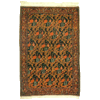 |
 |
With their high-density knotting and meticulous full-field designs,
Senneh carpets have long been attractive to Western markets. Frequent motifs are the herati (a complex play of floral elements located at the points of a diamond element) or the boteh (a shape vaguely similar to a teardrop with the point bent at one side) in repeating rows. |
 |
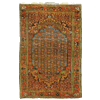 |
 |
Bidjar carpets are characterized by their rigid and rectilinear translations of classical decorations from the Safavid dynasty, particularly the vase layout, arabesques and floral vines. The lively colors of the decoration stand out against the dark backgrounds. |
 |
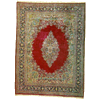 |
 |
Rugs of the Hamadan area are geometric and linear. The most common layouts use a medallion or superimposed medallions. Often the medallions are rhomboidal or hexagonal in shape with interiors decorated with geometric herati. |
 |
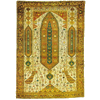 |
 |
In the area of Malayer, rugs tend to the geometric in design. Floral motifs often are used, either full field or alternating with rhomboidal medallions. Typical colors are reds and blues. |
 |
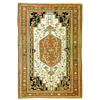 |
 |
Rugs from the area of Ferahan can be divided into two groups. Full-field decoration with floral motifs characterize the first group, while the second group uses a medallion layout that often is surrounded by jagged rays. |
 |
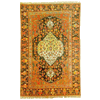 |
 |
The rugs of Sarouk or Sarough are easily recognized by their linear versions of traditional Persian floral decorations like vines, leaves and buds. In the 19th century, this linear style slowly was transformed into more curvilinear, naturalistic forms. The Sarouk area is known for its use of an intense salmon-pink color called dughi. |
 |
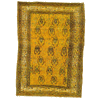 |
 |
Serabend rugs can be distinguished by their full-field layouts, composed exclusively of regular rows of tiny boteh. The background is always red, and the boteh usually are white, blue, black or yellow. |
 |

